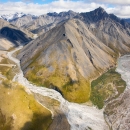This multi-year project has sought to reconnect habitat and restore fish passage fish passage
Fish passage is the ability of fish or other aquatic species to move freely throughout their life to find food, reproduce, and complete their natural migration cycles. Millions of barriers to fish passage across the country are fragmenting habitat and leading to species declines. The U.S. Fish and Wildlife Service's National Fish Passage Program is working to reconnect watersheds to benefit both wildlife and people.
Learn more about fish passage in Fairbanks, Alaska.
Cripple Creek’s natural channel was abandoned in 1935 when streamflow was diverted into an artificial drain constructed to carry wastewater and sediment from hydraulic mining activity in the Ester area. Though mining activity ceased years ago, the drain channel has remained the primary conduit for streamflow. The straight, channelized drain has offered relatively poor Chinook rearing habitat for many years.
The Interior Alaska Land Trust, in partnership with the U.S. Fish & Wildlife Service, studied the feasibility of restoring Cripple Creek in the lower Chena River watershed for almost a decade, including funding several extensive studies by Herrera Environmental Consultants and DOWL HKM Engineering. After years of seemingly insurmountable obstacles, restoring Cripple Creek became possible.
Beginning in 2017, four projects were targeted as having the biggest impacts on Cripple Creek’s restoration: improving the fish passage of the culvert at Old Chena Ridge Road; replacing culverts running underneath Chena Spur Road; and restoring the flow to the historic channel from Happy Creek and Cripple Creek drain. The Alaska Department of Transportation & Public Facilities (DOT&PF) reconnected two reaches of the abandoned natural channel by installing a new fish passage culvert at Chena Ridge Road. With their commitment to this single multi-million-dollar element, and through additional work by the Land Trust, Alaska DOT&PF removed the largest obstacle in restoring Cripple Creek.
Partnerships with the University of Alaska-Fairbanks helped overcome setbacks in the spring of 2020, when in-stream structures, designed to redirect flow to the original channel, were washed out. Student researchers discovered flow underneath the creek’s ice during the winter. A redesigned structure was successfully implemented in the late summer of 2022.
That autumn, clean water returned to Cripple Creek’s natural channel for the first time in more than 80 years. Research on water quality and fish passage in the creek continues today, many led by local partners and students in Fairbanks.






